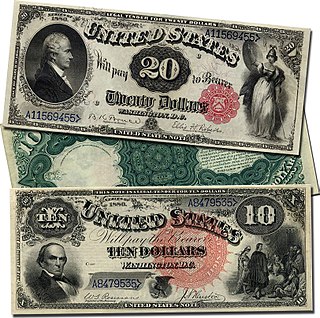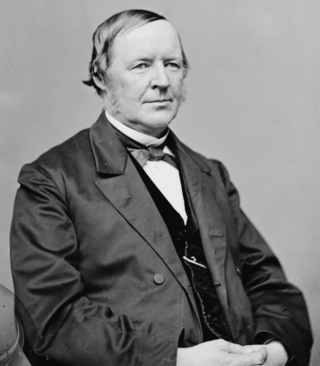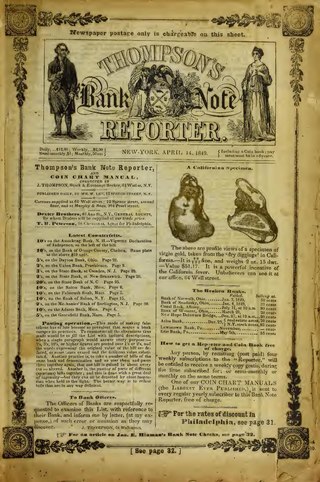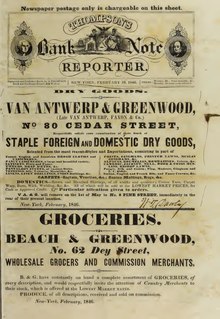Federal Reserve Notes, also United States banknotes, are the currently issued banknotes of the United States dollar. The United States Bureau of Engraving and Printing produces the notes under the authority of the Federal Reserve Act of 1913 and issues them to the Federal Reserve Banks at the discretion of the Board of Governors of the Federal Reserve System. The Reserve Banks then circulate the notes to their member banks, at which point they become liabilities of the Reserve Banks and obligations of the United States.

A United States Note, also known as a Legal Tender Note, is a type of paper money that was issued from 1862 to 1971 in the United States. Having been current for 109 years, they were issued for longer than any other form of U.S. paper money. They were known popularly as "greenbacks", a name inherited from the earlier greenbacks, the Demand Notes, that they replaced in 1862. Often termed Legal Tender Notes, they were named United States Notes by the First Legal Tender Act, which authorized them as a form of fiat currency. During the early 1860s the so-called second obligation on the reverse of the notes stated:
This Note is a Legal Tender for all debts public and private except Duties on Imports and Interest on the Public Debt; and is receivable in payment of all loans made to the United States.

A banknote—also called a bill, paper money, or simply a note—is a type of negotiable promissory note, made by a bank or other licensed authority, payable to the bearer on demand. Banknotes were originally issued by commercial banks, which were legally required to redeem the notes for legal tender when presented to the chief cashier of the originating bank. These commercial banknotes only traded at face value in the market served by the issuing bank. Commercial banknotes have primarily been replaced by national banknotes issued by central banks or monetary authorities.

The pound sterling is the official currency of the United Kingdom, Jersey, Guernsey, the Isle of Man, British Antarctic Territory, South Georgia and the South Sandwich Islands, and Tristan da Cunha.
The Greenback Party was an American political party with an anti-monopoly ideology which was active between 1874 and 1889. The party ran candidates in three presidential elections, in 1876, 1880 and 1884, before it faded away.

Hugh McCulloch was an American financier who played a central role in financing the American Civil War. He served two non-consecutive terms as U.S. Treasury Secretary under three presidents. He was originally opposed to the creation of a system of national banks, but his reputation as head of the Bank of Indiana 1857 to 1863 persuaded the Treasury to bring him in to supervise the new system as Comptroller of the Currency 1863–65. As Secretary of the Treasury 1865–69 he reduced and funded the gigantic Civil War debt of the union, and reestablished the federal taxation system across the former Confederate States of America. He tried but failed to make a rapid return to the gold standard.
This history of central banking in the United States encompasses various bank regulations, from early wildcat banking practices through the present Federal Reserve System.

Wildcat banking was the issuance of paper currency in the United States by poorly capitalized state-chartered banks. These wildcat banks existed alongside more stable state banks during the Free Banking Era from 1836 to 1865, when the country had no national banking system. States granted banking charters readily and applied regulations ineffectively, if at all. Bank closures and outright scams regularly occurred, leaving people with worthless money.

Counterfeit money is currency produced outside of the legal sanction of a state or government, usually in a deliberate attempt to imitate that currency and so as to deceive its recipient. Producing or using counterfeit money is a form of fraud or forgery, and is illegal in all jurisdictions of the world. The business of counterfeiting money is nearly as old as money itself: plated copies have been found of Lydian coins, which are thought to be among the first Western coins. Before the introduction of paper money, the most prevalent method of counterfeiting involved mixing base metals with pure gold or silver. Another form of counterfeiting is the production of documents by legitimate printers in response to fraudulent instructions. During World War II, the Nazis forged British pounds and American dollars. Today, some of the finest counterfeit banknotes are called Superdollars because of their high quality and imitation of the real US dollar. There has been significant counterfeiting of Euro banknotes and coins since the launch of the currency in 2002, but considerably less than that of the US dollar.

Counterfeiting of the currency of the United States is widely attempted. According to the United States Department of Treasury, an estimated $70 million in counterfeit bills are in circulation, or approximately 1 note in counterfeits for every 10,000 in genuine currency, with an upper bound of $200 million counterfeit, or 1 counterfeit per 4,000 genuine notes. However, these numbers are based on annual seizure rates on counterfeiting, and the actual stock of counterfeit money is uncertain because some counterfeit notes successfully circulate for a few transactions.

John Thompson was an American banker, financial publisher, and dealer in bank notes.
American Banker is a Manhattan-based trade publication covering the financial services industry. Originally a daily newspaper, the print edition ceased publication in 2016, but continues to be published as a print magazine 9 times per year. The first issue of American Banker was published in 1885, though it has been considered a continuation of the earlier Thompson's Bank Note Reporter, a bank note reporter which began publication in 1842.

John Jay Knox Jr. was an American financier and government official. He is best remembered as a primary author of the Coinage Act of 1873, which discontinued the use of the silver dollar.

The Bank of England, which is now the central bank of the United Kingdom, British Crown Dependencies and British Overseas Territories, has issued banknotes since 1694. In 1921 the Bank of England gained a legal monopoly on the issue of banknotes in England and Wales, a process that started with the Bank Charter Act of 1844 when the ability of other banks to issue notes was restricted.
The Sunday Mercury (1839–1896) was a weekly Sunday newspaper published in New York City that grew to become the highest-circulation weekly newspaper in the United States at its peak. It was known for publishing and popularizing the work of many notable 19th-century writers, including Charles Farrar Browne and Robert Henry Newell, and was the first Eastern paper to publish Mark Twain. It was also the first newspaper to provide regular coverage of baseball, and was popular for the extensive war correspondence from soldiers it published during the Civil War.

Card money was in use in New France in the seventeenth and eighteenth centuries. Official money cards were embossed with a fleur-de-lis and the signatures of the intendant, governor, and treasurer. Private cards would also use the fleur-de-lis and the signature of its debtor. Card money was generally issued, at least initially, in emergency situations when minted currency was in low supply, however over time "playing cards" became more popular and the standard tender. An estimated two million livres in card money is thought to have circulated prior to the British take over of New France territory in the 1760s.
The Forstall System was a banking system developed by Edmund Jean Forstall in 1842 and used until the end of the Civil War. After the Panic of 1837, banks underwent two main reformations. New York adapted a free banking system while Louisiana set up a banking system with specie reserve requirements. The Forstall System propelled Louisiana to economic maturity with its sound and credible banking system. It has been called one of the building blocks of the modern financial system still in place today.

Anthony Stumpf (1856–1927) was an American publisher of financial newspapers and bank directories who co-owned the American Banker newspaper and co-founded The American Lawyer.
The 5 yen note (5円券) was a denomination of Japanese yen in twelve different series from 1872 to 1955 for use in commerce. Only those from the "A series", which was issued from 1946 to 1955 are legal tender today.

Bank note reporters or counterfeit detectors were periodicals published in the United States in the mid-19th century. They were used by businesses for two purposes: to identify counterfeit bank notes, and to determine the discount rate for notes from distant banks.
















